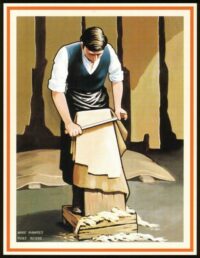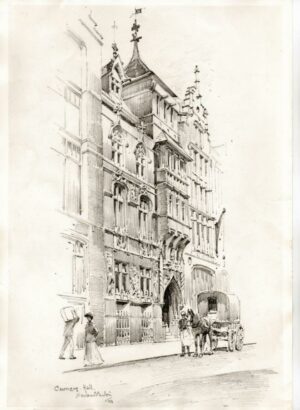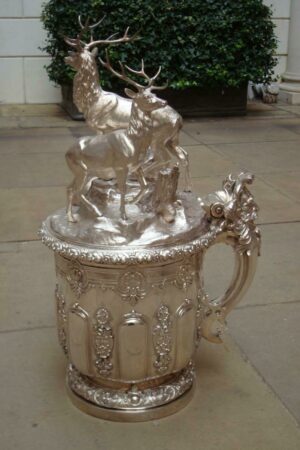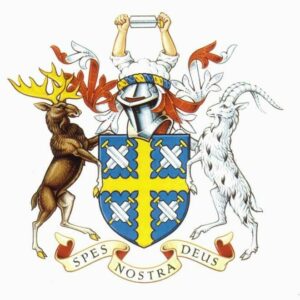
Company History
Historical Background

For innumerable centuries, currying was one of the ancient and essential leather industries. It cleaned, scraped, stretched and finished the tanned hides by oiling, waxing or colouring them to the desired surface finish. There is even a reference to currying in The Iliad.
The Company was first recorded as a trade organisation in 1272 when, within the walls of the City of London, curriers joined together in a trade association to protect the high standard of their craft and to ensure that their work was properly remunerated.
The Curriers' Company of the City of London was granted commercial autonomy by the Court of Common Council in 1415 and received its Charter of Incorporation from King James I in 1605.
Halls

Curriers Hall, 6 London Wall
Though they no longer have a hall of their own, the Curriers have owned no less that six halls during the six centuries of their corporate existence.
- Their first, at the junction of St Mary Axe and Bevis Marks was built in 1485.
- Their second was constructed on London Wall in 1583.
- A third hall replaced it in 1670.
- A fourth, again on the London Wall site, followed in 1820.
- Towards the end of the nineteenth century there came a period of extravaganza as, first, a new hall was built on London Wall in 1874, only to be demolished a year later.
- The sixth and last Curriers' Hall, at 6 London Wall, was erected with direct frontage onto the street. it opened in 1876 but was sold to the Imperial Continental Gas Association in 1921 (only to be destroyed in 1940 by enemy action).
Thereafter the Curriers shared the accommodation of the Cordwainers' Company until their hall too was destroyed by enemy action in 1941. In the following year they were invited to enjoy the hospitality of the Tallow Chandlers' Hall at 4 Dowgate Hill; and there they have remained.
The site of the 1876 Curriers' Hall was commemorated in 1999 by a blue plaque erected on a building in St Alphage Garden.
Treasures

The Stag at Bay
Among the treasures of the Curriers' Company are
- three silver tablespoons dating from the joint reign of William III and Mary II (one of which is extremely rare)
- a two-handled cup, hallmarked 1766
- a monumental silver tankard and cover, sometime referred to as "The Stag at Bay" which was made by Robert Garrard & Son in 1879
- the Master's badge of office, dating from 1884
- two silver loving cups commissioned by Norman Birkett from Omar Ramsden in 1937
Some of these treasures were displayed in the exhibition mounted in 1926 - 1927 by the Victoria and Albert Museum.
The Company also contributed to the "850 Years of London Livery Company Treasures" exhibition at the Guildhall Art Gallery in 2012.
Eminent Curriers
The Curriers have produced two Sheriffs and four Aldermen of the City of London. The Company's principal benefactors have been Thomas Sterne, William Dawes and John Rylands.
Other distinguished Liverymen include:
- John Maberly, MP
- Sir Francis Jeune, 1st Baron St Helier GCB PC QC
- Gordon Hewart, 1st Viscount Hewart, PC, KC (Lord Chief Justice)
- David Lloyd George, 1st Earl Lloyd-George of Dwyfor, OM, PC (Prime Minister)
- William Allen Jowitt, 1st Earl Jowitt, PC QC (Lord High Chancellor)
- William Norman Birkett, 1st Baron Birkett, PC, QC (the judge who played such a prominent part in the Nuremberg Trials)
- Edward Mayer (chess authority)
- Sir Philip Shelbourne (merchant banker and businessman)
A full list of Master Curriers is here.
Armorial Bearings

The coat of arms, together with its crest and supporters, was granted to the Company by Robert Cooke, Clarenceux King of Arms, in 1583. It illustrates the currier's shave, an essential tool of the trade.
The blue and gold shield has 4 pairs of shaves and is supported by (to the left) an elk with gold antlers and hooves and (to the right) a silver goat with black flashes. On top of the shield, the crest consists of a wreath, gold and blue, above which are clouds out of which two arms with rolled-up shirt sleeves hold aloft a single shave.
The meaning of the Latin motto 'SPES NOSTRA DEUS' is God is our hope.
